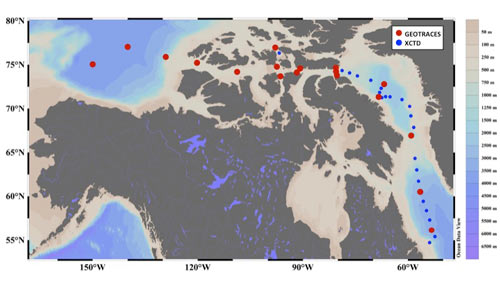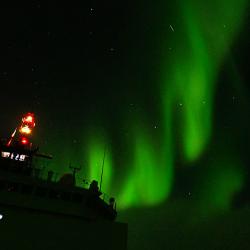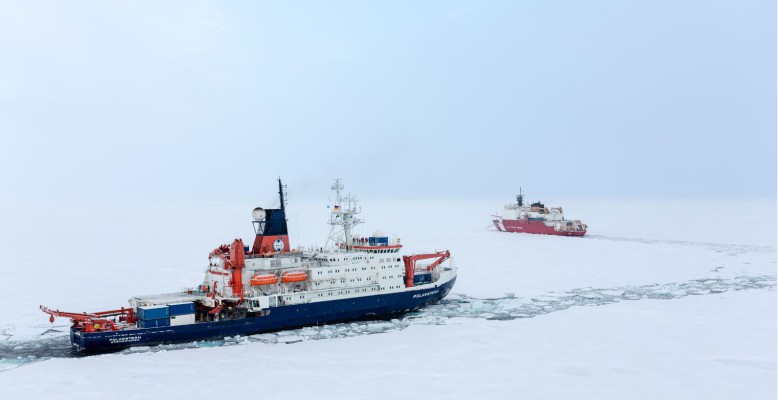GEOTRACES Arctic expeditions successfully completed
On October 14, the German Polarstern expedition arrived in Bremerhaven’s port. This cruise completed the International Arctic GEOTRACES field programme for 2015 consisting of four cruises from Canada, Germany and USA.
Canadian Arctic Programme
 The Canadian Arctic Programme “A biogeochemical and tracer study of a rapidly changing Arctic Ocean” consisting of two cruises (July 10 – August 20: Quebec City – Kugluktuk; September 4 – October 1: Sachs Harbour – Resolute) on board the CCGS Amundsen was successfully completed, notwithstanding a two-week hiatus in research during the first leg, arising from the diversion of the CCGS Amundsen to Hudson Bay to open sea lanes for commercial vessels (July 19 – August 3). All planned stations were occupied with the exception of one station in eastern Baffin Bay. This was achieved in large part thanks to our colleagues from the ArcticNet program, who cancelled most of their research planned for this leg to leave us enough time to complete most of our work.
The Canadian Arctic Programme “A biogeochemical and tracer study of a rapidly changing Arctic Ocean” consisting of two cruises (July 10 – August 20: Quebec City – Kugluktuk; September 4 – October 1: Sachs Harbour – Resolute) on board the CCGS Amundsen was successfully completed, notwithstanding a two-week hiatus in research during the first leg, arising from the diversion of the CCGS Amundsen to Hudson Bay to open sea lanes for commercial vessels (July 19 – August 3). All planned stations were occupied with the exception of one station in eastern Baffin Bay. This was achieved in large part thanks to our colleagues from the ArcticNet program, who cancelled most of their research planned for this leg to leave us enough time to complete most of our work.
During the first leg, 13 stations (two in the Labrador Sea, three in Baffin Bay, 8 in the Canadian Arctic Archipelago) were sampled for seawater with a regular and a trace metal clean rosette, and for marine particles with six large volume in-situ pumps. Productivity measurements using multiple isotopic methods and incubation experiments were also conducted, while trace gases measurements and aerosol sampling were performed under way. Twenty three XCTD were also deployed between stations in the Labrador Sea and Baffin Bay to supplement the hydrographic data.
During the second leg, 6 stations (three in Canada Basin and three in the Canadian Arctic Archipelago) were sampled for seawater and marine particles as during the first leg, and aerosols were sampled underway.
Chief Scientists of the cruise: Roger François and Philippe Tortell, University of British Columbia, Canada.
Figure: This map shows the stations from the Canadian Arctic expedition. Please click here to view the figure larger.
U.S. Arctic Programme
 The U.S. expedition returned safely to Dutch Harbor (Alaska, U.S) on October 11 following a long and successful Arctic cruise on board the U.S. Coast Guard Cutter Healy (HLY1502, GN01). A combined total of 66 GEOTRACES and Repeat Hydrography stations were occupied from August 9 to October 11.
The U.S. expedition returned safely to Dutch Harbor (Alaska, U.S) on October 11 following a long and successful Arctic cruise on board the U.S. Coast Guard Cutter Healy (HLY1502, GN01). A combined total of 66 GEOTRACES and Repeat Hydrography stations were occupied from August 9 to October 11.
The cruise accomplished its goals, which included ship-board collection of water and particles for both contamination and non-contamination prone elements, and aerosol sampling. Ice floe operations included sampling of under-ice seawater, snow, ice, and melt ponds. The expedition encountered surprisingly thin ice which led to relatively rapid transit, but reduced the number of sea ice stations that could be safely occupied. Although fall storms at the end of the cruise required that 3 of the final stations be abandoned, the majority of an ambitious cruise plan was fulfilled. In addition to a wealth of new science, this expedition marked the first time a U.S. surface ship reached the North Pole unescorted, a consequence of Arctic warming and reduced ice cover.
Chief Scientists of the cruise: David Kadko (Florida International University) and Bill Landing (Florida State University, co-chief).
Figure: © Bill Schmoker, PolarTREC.
German Arctic Programme
 Polarstern expedition PS94, named Transarc II, to the central Arctic Ocean arrived home on October 14. It had successfully completed GEOTRACES section cruise (GN04). In total 33 stations were sampled by a team of GEOTRACES scientists from the Netherlands, France, Spain, Germany, United Kingdom, Switzerland, Sweden, and Denmark. They carried out a transect from the Barents Sea through the Nansen and Amundsen Basin to the Makarov Basin, crossing the Lomonosov Ridge. Highlight of the expedition was the rendez-vous within USCG Healy at the North Pole where German and US teams had a memorable opportunity for occupying the same sampling station (crossover station), sharing experiences and knowledge.
Polarstern expedition PS94, named Transarc II, to the central Arctic Ocean arrived home on October 14. It had successfully completed GEOTRACES section cruise (GN04). In total 33 stations were sampled by a team of GEOTRACES scientists from the Netherlands, France, Spain, Germany, United Kingdom, Switzerland, Sweden, and Denmark. They carried out a transect from the Barents Sea through the Nansen and Amundsen Basin to the Makarov Basin, crossing the Lomonosov Ridge. Highlight of the expedition was the rendez-vous within USCG Healy at the North Pole where German and US teams had a memorable opportunity for occupying the same sampling station (crossover station), sharing experiences and knowledge.
The expedition had to be interrupted because of a medical emergency. After bringing the patient safely to Tromsø they were able to complete a section through the Bear Island trough between Svalbard and Norway, characterizing the Atlantic inflow to the Arctic through the Barents Sea, and therefore one of the Gateways to the Arctic Ocean.
Chief Scientist of the cruise: Ursula Schauer, AWI, Bremerhaven, Germany.
GEOTRACES Scientists: Michiel Rutgers van der Loeff (AWI, Germany) and Micha Rijkenberg (NIOZ, Netherlands).
Figure: USCGC Healy and RV Polarstern at the North Pole, 7 Sept. 2015. ©Stefan Hendricks. Source: blogs.helmholtz.de.
Outreach Programme
The International Arctic GEOTRACES field programme had a broad outreach programme including cruise blogs, videos, the participation of a PolarTREC teacher on board the U.S. expedition, the “Float the Boat” programme, radio interviews, educational outreach to U.S. Coast Guard personnel, outreach to local populations who depend on the Arctic Ocean for their livelihood,… Follow GEOTRACES outreach activities here. More outreach and educational materials from these expeditions will be developed!
We look forward to see all these data in the forthcoming GEOTRACES Intermediate Data Products and publications!
The GEOTRACES science is so exciting that even polar bears want to participate 😉
